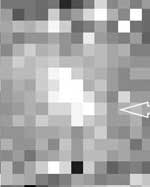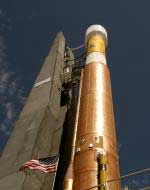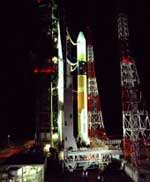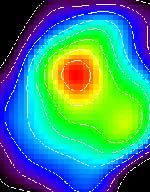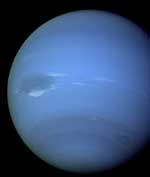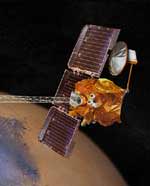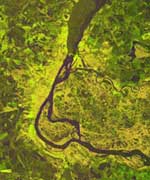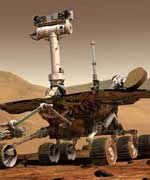
Image credit: NASA/JPL
NASA’s twin rovers, Spirit and Opportunity, are still on track to reach the Red Planet in early January. Spirit, which launched first, is scheduled to arrive on the evening of January 3, 2004 near the centre of Gusev Crater, which might have held a lake in the past. The spacecraft will jettison its cruise stage 15 minutes before hitting the top of the Martian atmosphere, and then will slow down to only 1,500 kph before deploying its parachute. 20 seconds later its retrorockets will fire and the spacecraft will cushion its final few metres with an airbag. The rover will then spend three months exploring the Martian surface.
NASA’S robotic Mars geologist, Spirit, embodying America’s enthusiasm for exploration, must run a grueling gantlet of challenges before it can start examining the red planet. Spirit’s twin Mars Exploration Rover, Opportunity, also faces tough Martian challenges.
“The risk is real, but so is the potential reward of using these advanced rovers to improve our understanding of how planets work,” said Dr. Ed Weiler, associate administrator for space science at NASA Headquarters, Washington.
Spirit is the first of two golf-cart-sized rovers headed for Mars landings in January. The rovers will seek evidence about whether the environment in two regions might once have been capable of supporting life. Engineers at NASA’s Jet Propulsion Laboratory (JPL), Pasadena, Calif., have navigated Spirit to arrive during the evening of Jan. 3, 2004, in the Eastern time zone.
Spirit will land near the center of Gusev Crater, which may have once held a lake. Three weeks later, Opportunity will reach the Meridiani Planum, a region containing exposed deposits of a mineral that usually forms under watery conditions.
“We’ve cleared two of the big hurdles, building both spacecraft and launching them,” said JPL’s Peter Theisinger, project manager for the Mars Exploration Rover Project. “Now we’re coming up on a third, getting them safely onto the ground,” he said.
Since their launches on June 10 and July 7 respectively, each rover has been flying tucked inside a folded-up lander. The lander is wrapped in deflated airbags, cocooned within a protective aeroshell and attached to a cruise stage that provides solar panels, antennas and steering for the approximately seven month journey.
Spirit will cast off its cruise stage 15 minutes before hitting the top of the Martian atmosphere at 5,400 meters per second (12,000 miles per hour). Atmospheric friction during the next four minutes will heat part of the aeroshell to about 1,400 C (2,600 F) and slow the descent to about 430 meters per second (960 mph). Less than two minutes before landing, the spacecraft will open its parachute.
Twenty seconds later, it will jettison the bottom half of its aeroshell, exposing the lander. The top half of the shell, still riding the parachute, will lower the lander on a tether. In the final six seconds, airbags will inflate, retro rockets on the upper shell will fire, and the tether will be cut about 15 meters (49 feet) above the ground.
Several bounces and rolls could take the airbag-cushioned lander about a kilometer (0.6 mile) from where it initially lands. If any of the initial few bounces hits a big rock that’s too sharp, or if the spacecraft doesn’t complete each task at just the right point during the descent, the mission could be over. More than half of all the missions launched to Mars have failed.
JPL Director Dr. Charles Elachi said, “We have done everything we know that could be humanly done to ensure success. We have conducted more testing and external reviews for the Mars Exploration Rovers than for any previous interplanetary mission.”
Landing safely is the first step for three months of Mars exploration by each rover. Before rolling off its lander, each rover will spend a week or more unfolding itself, rising to full height, and scanning surroundings. Spirit and Opportunity each weigh about 17 times as much as the Sojourner rover of the 1997 Mars Pathfinder mission. They are big enough to roll right over obstacles nearly as tall as Sojourner.
“Think of Spirit and Opportunity as robotic field geologists,” said Dr. Steve Squyres of Cornell University, Ithaca, N.Y., principal investigator for the rovers’ identical sets of science instruments. “They look around with a stereo, color camera and with an infrared instrument that can classify rock types from a distance. They go to the rocks that seem most interesting. When they get to one, they reach out with a robotic arm that has a handful of tools, a microscope, two instruments for identifying what the rock is made of, and a grinder for getting to a fresh, unweathered surface inside the rock,” he said.
JPL, a division of the California Institute of Technology in Pasadena, manages the Mars Exploration Rover project for NASA’s Office of Space Science, Washington. For information about the Mars Exploration Rover project on the Internet, visit:
For Cornell University’s Web site about the science payload, visit:
Original Source: NASA/JPL News Release

